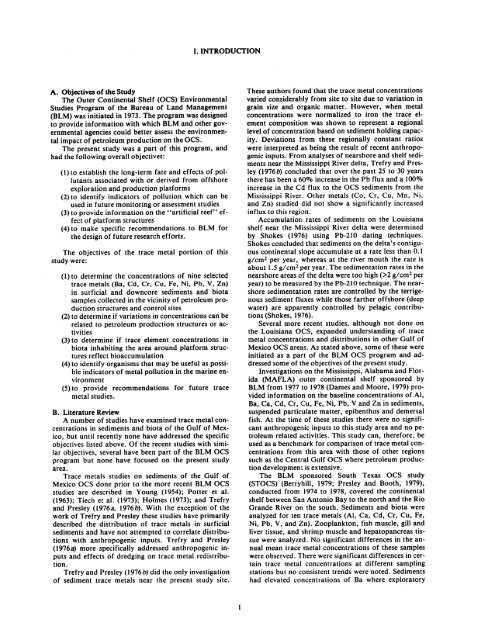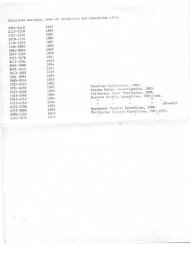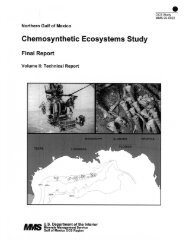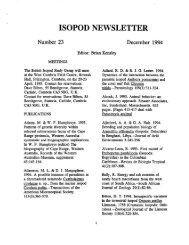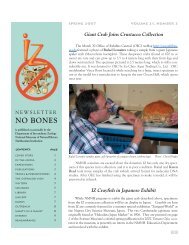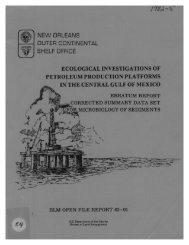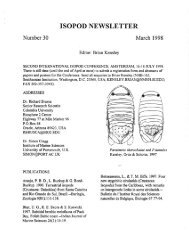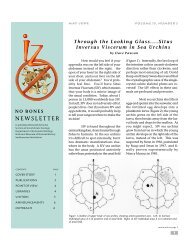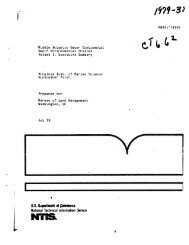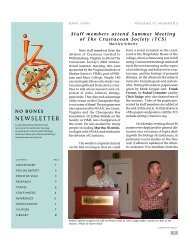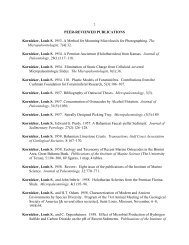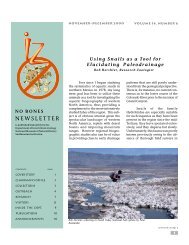Vol.1 part 4-5 - Department of Invertebrate Zoology
Vol.1 part 4-5 - Department of Invertebrate Zoology
Vol.1 part 4-5 - Department of Invertebrate Zoology
Create successful ePaper yourself
Turn your PDF publications into a flip-book with our unique Google optimized e-Paper software.
I . INTRODUCTION<br />
A. Objectives <strong>of</strong> the Study<br />
The Outer Continental Shelf (OCS) Environmental<br />
Studies Program <strong>of</strong> the Bureau <strong>of</strong> Land Management<br />
(BLM) was initiated in 1973 . The program was designed<br />
to provide information with which BLM and other governmental<br />
agencies could better assess the environmental<br />
impact <strong>of</strong> petroleum production on the OCS .<br />
The present study was a <strong>part</strong> <strong>of</strong> this program, and<br />
had the following overall objectives :<br />
(1) to establish the long-term fate and effects <strong>of</strong> pollutants<br />
associated with or derived from <strong>of</strong>fshore<br />
exploration and production platforms<br />
(2) to identify indicators <strong>of</strong> pollution which can be<br />
used in future monitoring or assessment studies<br />
(3) to provide information on the "artificial reef" effect<br />
<strong>of</strong> platform structures<br />
(4) to make specific recommendations to BLM for<br />
the design <strong>of</strong> future research efforts .<br />
The objectives <strong>of</strong> the trace metal portion <strong>of</strong> this<br />
study were :<br />
(1) to determine the concentrations <strong>of</strong> nine selected<br />
trace metals (Ba, Cd, Cr, Cu, Fe, Ni, Pb, V, Zn)<br />
in surficial and downcore sediments and biota<br />
samples collected in the vicinity <strong>of</strong> petroleum production<br />
structures and control sites<br />
(2) to determine if variations in concentrations can be<br />
related to petroleum production structures or activities<br />
(3) to determine if trace element concentrations in<br />
biota inhabiting the area around platform structures<br />
reflect bioaccumulation<br />
(4) to identify organisms that may be useful as possible<br />
indicators <strong>of</strong> metal pollution in the marine environment<br />
(5) to provide recommendations for future trace<br />
metal studies .<br />
B . Literature Review<br />
A number <strong>of</strong> studies have examined trace metal concentrations<br />
in sediments and biota <strong>of</strong> the Gulf <strong>of</strong> Mexico,<br />
but until recently none have addressed the specific<br />
objectives listed above . Of the recent studies with similar<br />
objectives, several have been <strong>part</strong> <strong>of</strong> the BLM OCS<br />
program but none have focused on the present study<br />
area .<br />
Trace metals studies on sediments <strong>of</strong> the Gulf <strong>of</strong><br />
Mexico OCS done prior to the more recent BLM OCS<br />
studies are described in Young (1954) ; Potter et al .<br />
(1963) ; Tiech et al . (1973) ; Holmes (1973) ; and Trefry<br />
and Presley (1976a, 19766) . With the exception <strong>of</strong> the<br />
work <strong>of</strong> Trefry and Presley these studies have primarily<br />
described the distribution <strong>of</strong> trace metals in surficial<br />
sediments and have not attempted to correlate distributions<br />
with anthropogenic inputs . Trefry and Presley<br />
(19'76a) more specifically addressed anthropogenic inputs<br />
and effects <strong>of</strong> dredging on trace metal redistribution<br />
.<br />
Trefry and Presley (19766) did the only investigation<br />
<strong>of</strong> sediment trace metals near the present study site .<br />
These authors found that the trace metal concentrations<br />
varied considerably from site to site due to variation in<br />
grain size and organic matter . However, when metal<br />
concentrations were normalized to iron the trace element<br />
composition was shown to represent a regional<br />
level <strong>of</strong> concentration based on sediment holding capacity<br />
. Deviations from these regionally constant ratios<br />
were interpreted as being the result <strong>of</strong> recent anthropogenic<br />
inputs . From analyses <strong>of</strong> nearshore and shelf sediments<br />
near the Mississippi River delta, Trefry and Presley<br />
(19766) concluded that over the past 25 to 30 years<br />
there has been a 60% increase in the Pb flux and a 100%<br />
increase in the Cd flux to the OCS sediments from the<br />
Mississippi River . Other metals (Co, Cr, Cu, Mn, Ni,<br />
and Zn) studied did not show a significantly increased<br />
influx to this region .<br />
Accumulations rates <strong>of</strong> sediments on the Louisiana<br />
shelf near the Mississippi River delta were determined<br />
by Shokes (1976) using Pb-210 dating techniques .<br />
Shokes concluded that sediments on the delta's contiguous<br />
continental slope accumulate at a rate less than 0 .1<br />
g/cm2 per year, whereas at the river mouth the rate is<br />
about 1 .5 g/cm2 per year . The sedimentation rates in the<br />
nearshore areas <strong>of</strong> the delta were too high (>2 g/cm2 per<br />
year) to be measured by the Pb-210 technique . The nearshore<br />
sedimentation rates are controlled by the terrigenous<br />
sediment fluxes while those farther <strong>of</strong>fshore (deep<br />
water) are apparently controlled by pelagic contributions<br />
(Shokes, 1976) .<br />
Several more recent studies, although not done on<br />
the Louisiana OCS, expanded understanding <strong>of</strong> trace<br />
metal concentrations and distributions in other Gulf <strong>of</strong><br />
Mexico OCS areas . As stated above, some <strong>of</strong> these were<br />
initiated as a <strong>part</strong> <strong>of</strong> the BLM OCS program and addressed<br />
some <strong>of</strong> the objectives <strong>of</strong> the present study .<br />
Investigations on the Mississippi, Alabama and Florida<br />
(MAFLA) outer continental shelf sponsored by<br />
BLM from 1977 to 1978 (Dames and Moore, 1979) provided<br />
information on the baseline concentrations <strong>of</strong> Al,<br />
Ba, Ca, Cd, Cr, Cu, Fe, Ni, Pb, V and Zn in sediments,<br />
suspended <strong>part</strong>iculate matter, epibenthos and demersal<br />
fish . At the time <strong>of</strong> these studies there were no significant<br />
anthropogenic inputs to this study area and no petroleum<br />
related activities . This study can, therefore, be<br />
used as a benchmark for comparison <strong>of</strong> trace metal concentrations<br />
from this area with those <strong>of</strong> other regions<br />
such as the Central Gulf OCS where petroleum production<br />
development is extensive .<br />
The BLM sponsored South Texas OCS study<br />
(STOCS) (Berryhill, 1979 ; Presley and Booth, 1979),<br />
conducted from 1974 to 1978, covered the continental<br />
shelf between San Antonio Bay to the north and the Rio<br />
Grande River on the south . Sediments and biota were<br />
analyzed for ten trace metals (Al, Ca, Cd, Cr, Cu, Fe,<br />
Ni, Pb, V, and ln) . Zooplankton, fish muscle, gill and<br />
liver tissue, and shrimp muscle and hepatopancreas tissue<br />
were analyzed . No significant differences in the annual<br />
mean trace metal concentrations <strong>of</strong> these samples<br />
were observed . There were significant differences in certain<br />
trace metal concentrations at different sampling<br />
stations but no consistent trends were noted . Sediments<br />
had elevated concentrations <strong>of</strong> Ba where exploratory


